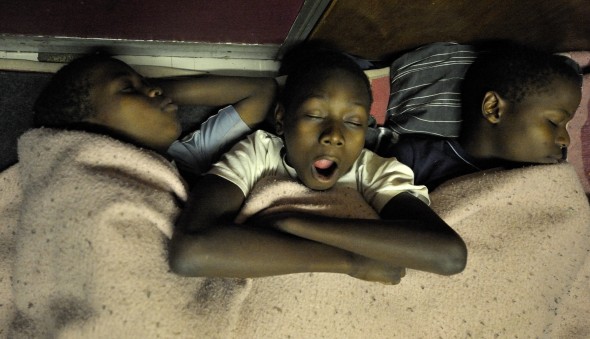Global Lens Reflections on life, the universe, and everything
Sleepless in South Africa
I have acquired some penpals. Let me tell you how that happened.
Last year I was in South Africa to work on a couple of stories, one of them on the plight of Zimbabwean refugees who have been exploited, abused and even murdered. In the middle of this depressing story–as are many stories of immigration–I focused on how Central Methodist Church in downtown Johannesburg has become a safe refuge for the persecuted migrants. On any given day, more than 3,000 sleep in the church. Pastor Paul Verryn ends his benediction at the nightly worship service with the words, “Go in peace, sleep well,” and the refugees scramble to every corner of the church to sleep, with the overflow crowd spreading blankets and cardboard on nearby sidewalks.
Here’s a gallery of images from the assignment.
The hospitality of the church has its critics, as I described in an article I wrote for the Christian Century. Yet in addition to the somewhat expected criticism and threats from local business owners and xenophobic South Africans, Verryn has also had to confront threats to his ministry from within his own church, the Methodist Church of Southern Africa.
The ecclesiastical problems emerge, in part, from the fact that running a crowded church building that has become a city is, to say the least, a management nightmare. One of the issues Verryn and his staff have faced is the sexual abuse of women and children within the walls of the church. To confront the problem, last year the congregation trained a committee of ten refugees—eight women and two men—to investigate complaints and take action to stop abuse. Nonetheless, Verryn faced accusations that he hadn’t done enough to stop the abuse of children. Verryn finally moved several refugee girls to a church dormitory in Soweto, where they would be safer, while at the same time helping to initiate court proceedings to have a legal guardian appointed for the children.
There’s a problem with that. Ministers of the Methodist Church of Southern Africa aren’t allowed to initiate legal action on their own, nor can they speak to the media—though Verryn has not been shy about doing just that, including to me. And he’s an articulate guy who’s not given to mincing words.
In January, Verryn was suspended by church leaders, who refused to detail the charges publicly, leading to speculation of deeper problems, such that he was somehow involved in the abuse. It struck me as some sort of pissing match between Verryn, a former bishop, and the church’s current leadership who is jealous of his protagonism and public profile. And it came at a particularly bad time, as the social cleansing of migrants has accelerated in the lead up to the World Cup.
Verryn energetically protested both the charges and the secrecy around them, and both sides agreed to arbitration. Although officially suspended, he continued his work at Central, albeit quietly, though refusing to speak to journalists. In May the arbitrator ruled in Verryn’s favor. The charges were dropped and Verryn’s suspension ended.
I still hear regularly via email from some boys that I met at the church. I spent one evening with them as they got ready to sleep on the floor of a church room reserved for them. Some of them told me horrendous stories of their journey from Zimbabwe to South Africa, and we discussed the challenges they faced in a society where some don’t want them around and where many blame them for all variety of social ills. It’s an oft-repeated scenario, including in the United States.
I photographed them as they lay down on the floor, covered up with blankets, and started to go to sleep. But a few weren’t that sleepy so we started talking quietly. A couple of them wanted my email address (no matter how poor you are, you can have an email address). Then they announced that since I had interviewed them, they had the right to interview me. Ok, that’s fair. I wrote some of their questions down in my notebook. Coming from some of the poorest people on earth, they are a primer on globalization.
Do you know Oprah?
Is it true you don’t have elephants in the United States?
Is wrestling real?
Have you met Tom Cruise? Mel Gibson? Brad Pitt? Etc.
Do you have dirt roads?
Do people in your country eat porridge like us?
Do kids there walk to school without shoes?
Can you walk five kilometers without shoes?
Do you have any wild animals there?
Are Indians red?
How much does a mountain bike cost?
I tried to turn the conversation back to their situation by describing the similarities of how we treat Mexican migrants in the U.S. That didn’t get us anywhere. One asked me, “How can you tell who is a Mexican?”

Pingback: The photograph used on the book cover …Sanctuary - Home of Christa Kuljian | Sanctuary - Home of Christa Kuljian